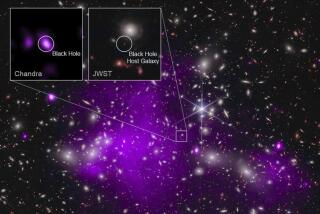‘Birth’ of Black Hole Is Glimpsed
- Share via
NASA’s Swift spacecraft has captured what scientists believe to be the “birth cry” of a black hole caused by the collision of two neutron stars a billion light-years from Earth.
The discovery, announced Tuesday, is the best evidence so far that scientists may have found what causes short bursts of high-energy gamma rays, one of the most powerful sources of electromagnetic radiation in the universe.
When Swift was launched in November, scientists said solving the mystery of these fleeting events of almost unimaginable power would be the spacecraft’s primary job.
“I think we have a smoking gun here,” said Neil Gehrels, the lead scientist on the Swift mission at the Goddard Space Flight Center in Greenbelt, Md.
Scientists will continue to study the latest results, but Gehrels said he felt comfortable with the explanation that short gamma ray bursts were caused by the collision and explosion of two neutron stars.
Neutron stars are compact objects that cram the mass of the sun into a space about the size of a city. Their densities are similar to the nucleus of an atom.
Gamma ray bursts were discovered more than three decades ago by scientists who at first had trouble believing what they were measuring in the distant reaches of the cosmos. Each burst burns as brightly as a billion-billion suns, yet lasts only moments.
There are two types. Long bursts last up to 100 seconds, while short bursts last milliseconds.
That made studying them extremely difficult. They were gone before the speediest instruments could pinpoint their locations. The $239-million Swift mission -- a collaboration between NASA, Britain and Italy -- was designed to solve the problem by allowing the spacecraft to nimbly pivot in space to track down a burst before all evidence vanished.
Scientists had previously concluded that long bursts are the result of a hypernova, the explosion of a giant star.
The solution to the short burst question had eluded them until Sunday, when Swift was able, in 53 seconds, to home in on one coming from the edge of a distant elliptical galaxy, said Steinn Sigurdsson, a professor of astronomy at Pennsylvania State University.
“This is the first short burst we have ever captured,” he said.
Swift will help astrophysicists better understand high-energy physics, and could help solve a problem of Einsteinian physics that has eluded researchers for decades. One of Albert Einstein’s still unconfirmed predictions was that gravity produced waves that should be able to be measured.
Those waves are so tiny, however, that no instrument has been able to measure them. Sigurdsson said colliding neutron stars should produce the sort of gravity waves that scientists were looking for.






